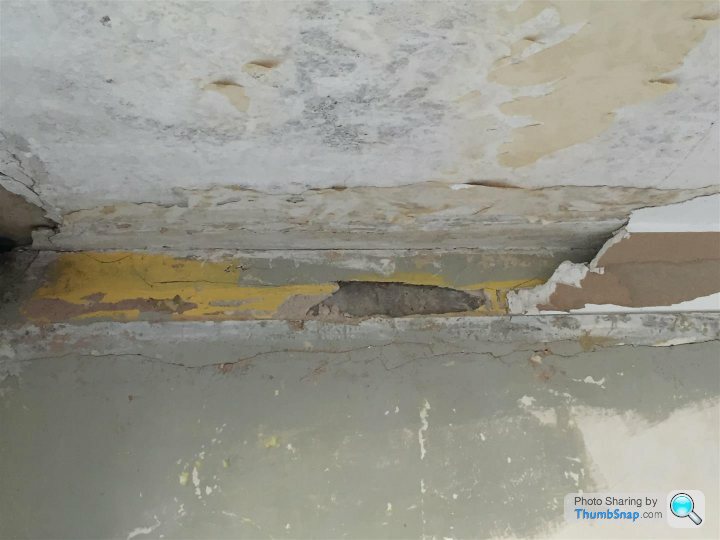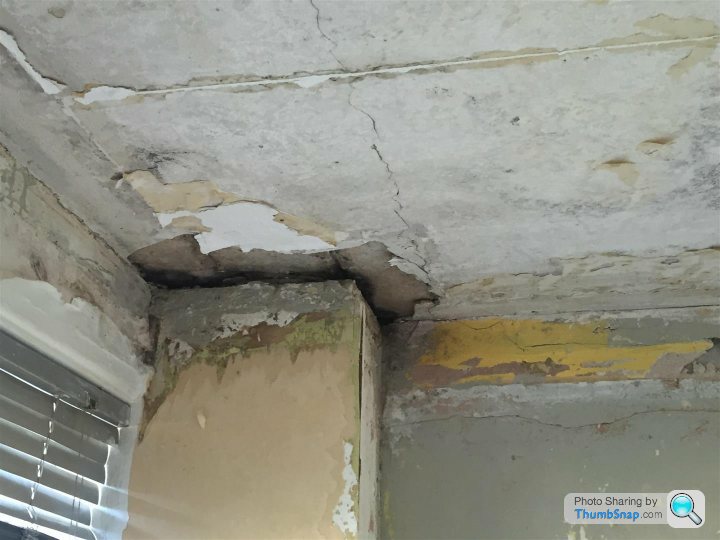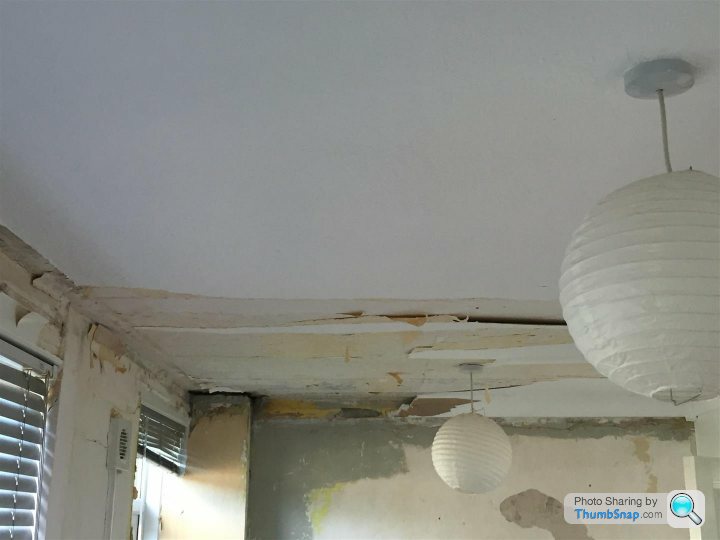Insulation plasterboard in a flat with concrete beam ceiling
Discussion
Hi guys
Just looking for a bit of advice. My second floor (and top) flat has a solid concrete ceiling which looks like some form of steel-reinforced beams of quite some length, spanning across entire dining room and lounge areas so are really long it appears.
Anyway, I am fixing insulated plasterboard to the ceilings and walls. The ceiling has a c.15mm thick kind of plaster attached that has string reinforcement/netting contained within it. I have attached photos to show what the concrete beams look like. THe walls are blockwork inner leaf with a brick outer leaf. They also in places have the plaster/string covering. What I want to know is, should i remove this plaster/string covering to reveal bare blockwork to the walls, and bare concrete beams to the ceilings and then fix to this, or leave as is and simply drill straight through?
The benefits of removing are that I will claim back some height and width as the insulated pboards are fairly thick. I remove the risk of the plaster failing and the pboards coming loose as well. Risks i can see are the plaster provides a further barrier to the cold surface including barrier against quicker moisture ingress.
Thoughts?




Just looking for a bit of advice. My second floor (and top) flat has a solid concrete ceiling which looks like some form of steel-reinforced beams of quite some length, spanning across entire dining room and lounge areas so are really long it appears.
Anyway, I am fixing insulated plasterboard to the ceilings and walls. The ceiling has a c.15mm thick kind of plaster attached that has string reinforcement/netting contained within it. I have attached photos to show what the concrete beams look like. THe walls are blockwork inner leaf with a brick outer leaf. They also in places have the plaster/string covering. What I want to know is, should i remove this plaster/string covering to reveal bare blockwork to the walls, and bare concrete beams to the ceilings and then fix to this, or leave as is and simply drill straight through?
The benefits of removing are that I will claim back some height and width as the insulated pboards are fairly thick. I remove the risk of the plaster failing and the pboards coming loose as well. Risks i can see are the plaster provides a further barrier to the cold surface including barrier against quicker moisture ingress.
Thoughts?




Rickyy said:
No way would I hack that off! Wooden frame drilled to the concrete, then plasterboard on the frame.
You'll be there forever drilling and plugging every hole needed to fix plasterboard straight to concrete!
This 100%, roofing lats screwed to concrete then pb over the top,You'll be there forever drilling and plugging every hole needed to fix plasterboard straight to concrete!
Use thermaline board (whichever thickness is appropriate) for the easiest method,
Personally I would look at using a 2x2 timber frame with 50mm celotex in between then pb over the lot, this would save in height lost too if that's of any concern
Edited by brianb on Saturday 27th August 09:46
If it's sound leave it, if loose take it down. I'd go with the batten idea as well; 50mm x 25mm slate batten@ 600mm centres, Kingspan insulation in between, vapour barrier, then your insulated plasterboard. You could go with thicker battens etc. it just depends on how much height you want to lose. You can get insulated plasterboard with an integral vapour barrier which would be better but they're pretty pricy. Don't know what the 'string' stuff you refer to is, could be hessian scrim, though you only tend to use that at joints and junctions.
Rickyy said:
No way would I hack that off! Wooden frame drilled to the concrete, then plasterboard on the frame.
You'll be there forever drilling and plugging every hole needed to fix plasterboard straight to concrete!
lYou'll be there forever drilling and plugging every hole needed to fix plasterboard straight to concrete!
We had the same problem with the nasty 80's extension on the back of our 1930's house. Frame and board was easy, no mess, and just costs a couple more inch s of ceiling height. Also fitted spotlights and ceiling speakers etc into the frame, which would be impossible if we had just stuck board to the concrete somehow.
Gassing Station | Homes, Gardens and DIY | Top of Page | What's New | My Stuff



